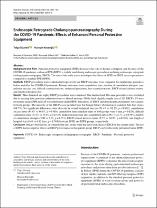| dc.contributor.author | Düzenli, Tolga | |
| dc.contributor.author | Köseoğlu, Hüseyin | |
| dc.date.accessioned | 2021-11-01T15:05:24Z | |
| dc.date.available | 2021-11-01T15:05:24Z | |
| dc.date.issued | 2021 | |
| dc.identifier.citation | Düzenli, T., & Köseoğlu, H. (2021). Endoscopic Retrograde Cholangiopancreatography During the COVID-19 Pandemic: Effects of Enhanced Personal Protective Equipment. Digestive Diseases and Sciences, 1-7. | en_US |
| dc.identifier.issn | 0163-2116 | |
| dc.identifier.issn | 1573-2568 | |
| dc.identifier.uri | https://doi.org/10.1007/s10620-021-06940-4 | |
| dc.identifier.uri | https://hdl.handle.net/11491/7262 | |
| dc.description.abstract | Background and Aims Personal protective equipment (PPE) decreases the risk of disease contagion, and because of the COVID-19 pandemic, enhanced PPE (EPPE) is widely used during endoscopic procedures including endoscopic retrograde cholangiopancreatography (ERCP). The aim of this study was to investigate the effects of EPPE on ERCP success parameters compared to standard PPE (SPPE). Methods ERCP procedures were evaluated retrospectively and ERCP outcomes were compared for similar time periods as before and after the COVID-19 pandemic. Primary outcomes were cannulation time, number of cannulation attempts, cannulation success rate, difficult cannulation rate, undesired pancreatic duct cannulation rate, ERCP-related adverse events, and length of hospital stay. Results Three hundred and eighty ERCP procedures were examined. One hundred and fifty-nine procedures were excluded due to missing data, previous sphincterotomy or altered anatomy. Of the final eligible sample size of 221 ERCPs, 93 were performed using SPPE and 128 were performed under EPPE. Indications of ERCP and demographic parameters were similar between groups. The majority of the ERCP cases included were for benign biliary obstruction of common bile duct stones (88.7%). No significant differences were detected in overall technical success (91.4% vs 92.2%, p = 0.832), cannulation success rates (94.6% vs 96.8%, p = 0.403), cannulation times (median times of both groups were 3 min, p = 0.824), difficult cannulation rates (37.6% vs 33.6%, p = 0.523), undesired pancreatic duct cannulation rates (29% vs 22.7%, p = 0.593), number of cannulation attempts (2.80 vs 2.71, p = 0.731), ERCP-related adverse events (9.7% vs 10.9%, p = 0.762), and length of hospital stay (6.63 vs 6.92 days, p = 0.768) between SPPE and EPPE groups, respectively. Conclusion Biliary obstructions of common bile duct stones were the major indication of ERCP in the current study. The use of EPPE had no negative effects on ERCP performance in this patient group. ERCP can be effectively performed under EPPE. | en_US |
| dc.language.iso | eng | en_US |
| dc.publisher | Springer | en_US |
| dc.relation.ispartof | Digestive Diseases And Sciences | en_US |
| dc.rights | info:eu-repo/semantics/openAccess | en_US |
| dc.subject | COVID-19 | en_US |
| dc.subject | Endoscopic Retrograde Cholangiopancreatography | en_US |
| dc.subject | ERCP | en_US |
| dc.subject | Pandemic | en_US |
| dc.subject | Personal Protective Equipment | en_US |
| dc.title | Endoscopic Retrograde Cholangiopancreatography During the COVID-19 Pandemic: Effects of Enhanced Personal Protective Equipment | en_US |
| dc.type | article | en_US |
| dc.department | Hitit Üniversitesi, Tıp Fakültesi, Dahili Tıp Bilimleri Bölümü | en_US |
| dc.authorid | Düzenli, Tolga / 0000-0002-6279-1018 | |
| dc.authorid | Köseoğlu, Hüseyin / 0000-0002-2197-7473 | |
| dc.identifier.volume | 66 | en_US |
| dc.identifier.issue | 6 | en_US |
| dc.identifier.startpage | 1845 | en_US |
| dc.identifier.endpage | 1851 | en_US |
| dc.relation.publicationcategory | Makale - Uluslararası Hakemli Dergi - Kurum Öğretim Elemanı | en_US |
| dc.department-temp | [Duzenli, Tolga; Koseoglu, Huseyin] Hitit Univ, Erol Olcok Training & Res Hosp, Dept Gastroenterol, Corum, Turkey | en_US |
| dc.contributor.institutionauthor | Düzenli, Tolga | |
| dc.contributor.institutionauthor | Köseoğlu, Hüseyin | |
| dc.identifier.doi | 10.1007/s10620-021-06940-4 | |
| dc.authorwosid | Düzenli, Tolga / R-8685-2019 | |
| dc.description.wospublicationid | WOS:000631771500001 | en_US |
| dc.description.scopuspublicationid | 2-s2.0-85102890868 | en_US |
| dc.description.pubmedpublicationid | PubMed: 33755824 | en_US |


















